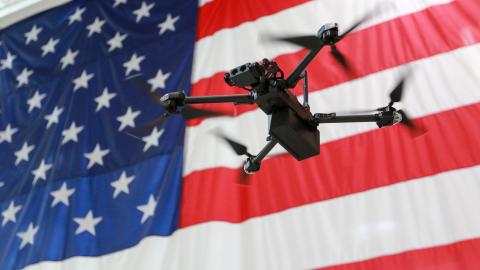Jerry Hendrix of the Center for a New American Security took to the pages of National Review this week (“Drydock Time: The Navy’s Aircraft Carriers Are Yesterday’s Weapons” to advocate the elimination of the aircraft carrier from the arsenal of the U.S. Navy. A former naval aviator, Hendrix is a serious man and a gifted navalist, so his arguments should be taken seriously. Under scrutiny, however, his logic wilts, his understanding of modern warfare is revealed as unrealistic, and his ability to hone in on actual cause-and-effect relationships is questionable.
Hendrix invests 2,700-plus words in an argument for eliminating the aircraft carrier, yet undercuts himself effectively with only 32: “The same outside observer would also discern where the difficulty with the carrier design lies. The efficacy of the carrier lies not in the ship but in the capabilities of its planes.” This raises the question of whether Hendrix’s target is the aircraft carrier or the weapons system (airplanes) it employs. And while he wishes to ride the wave of notoriety as a notable carrier critic, his argument essentially boils down to this: “The airplanes the carrier employs require it to operate too close to danger. Therefore, we should get rid of carriers.”
This logic ignores seven decades of history and experience in which the airplanes assigned to the carrier have changed dramatically in response to the missions that were asked of the Navy. And while he quite rightly points to the current airwing’s lack of useful range as highly problematic, he fails to note this was itself a choice made by the Navy to reflect the threat environment. When the Berlin Wall fell, there was no power that could check the U.S. Navy at sea, and therefore the carrier could operate much closer to land. Aircraft range as an attribute was deemphasized. Now that there is a rising threat of powers capable of more aggressively targeting the carrier, it will, in some scenarios, have to operate from farther away. If the Navy chooses to build the right airplanes, the carrier will remain central to U.S. power projection.
Keep in mind, though, that the carrier does not simply charge into the teeth of an aggressive targeting environment and disgorge itself of its strike aircraft from unending sanctuary. It fights as part of a larger combat system, that of the Joint Force. Elements of the enemy’s surveillance network would necessarily be targeted for destruction by precision weapons launched from submarines, other ships, or long-range bombers. An elaborate cyber campaign would also be key to blinding an opponent, creating a window of opportunity for the carrier to launch its strikes before relocating. As this process is repeated over time, the risks to the carrier dissipate, and it can move closer to the defended territory, thereby enabling higher-tempo strike operations.
We are not advocating that the Navy transform its airwing simply to extend the life of the aircraft carrier, as this would expose our thinking to the dreaded “self-licking ice-cream cone” charge. We, like Hendrix, advocate extending the striking range of the carrier airwing because it makes operational sense. The ability to project power ashore from a constantly moving platform at sea remains this nation’s primary competitive military advantage in a world in which our interests are often found thousands of miles from our own shores. The mobility of the carrier means that this nation will be able to project power when stationary, land-based airfields have come under attack, a proposition that is considerably easier than locating, targeting, fixing, and engaging a mobile aircraft carrier.
Another troubling aspect of Hendrix’s piece is its flawed historical and naval analysis, specifically of how the battle in the Pacific unfolded in World War II and the relationship of that campaign to a potential future showdown with the Chinese. Hendrix writes:
Recently, in apparent recognition of these strategic challenges, Navy leaders and their supporters in industry and think tanks have begun to advance the argument that, when dealing with [an enemy that can attack a carrier stationed nearby], it is not necessary to project power ashore: Rather, the Navy and its carriers should conduct a campaign to control the sea, slowly destroying their opponent’s navy and interdicting its trade over time to eventually degrade its capabilities and roll back its defenses. This approach is very much in line with what the U.S. Navy did in World War II, but it ignores the overarching strategy the U.S. pursued in that war.
Not only is this approach very much a minority view in the think-tank community, it would be difficult indeed to find authoritative statements by any “Navy leaders” that reflect it. In fact, the much-discussed Navy/Air Force concept of Air-Sea Battle was explicitly described in terms of projecting power.
But putting aside Hendrix’s mistaken view of modern warfare, the approach cited above is decidedly not how the WWII campaign in the Pacific was conducted.
The Navy conducted a prolonged sea-control campaign to destroy the Japanese navy, and thereby create space and support for its Marine and Army brethren to capture islands. . . . The point of the entire World War II Pacific campaign was not to gain sea control and attrite Japanese naval forces, but rather to bring U.S. forces within range of the Japanese capital in order to project power and bring the war to an end.
This statement, while it may contain a kernel of truth in its portrayal of the strategic objective in World War II, ignores the indisputable fact that the actual campaigns underlying it were utterly dependent on maritime power projection aimed at intermediate targets, undertaken from areas where the U.S. Navy had established sea control. It is not hard to believe that a conflict with China might have much in common with the preliminary stages of the World War II campaign, even if fears of nuclear retaliation would preclude targeting the Chinese mainland. Carriers were essential in the WWII campaign, and they would be essential in a modern reprise thereof.
What seems ultimately to most bother Hendrix is the cost of buying an aircraft carrier, which he cites at $14 billion, although the Navy publicly puts it at $12.8 billion. Either number is admittedly a lot of money. This cost, in combination with the 5,000 people needed to operate a modern carrier, creates for Hendrix a situation in which he believes U.S. leadership would not risk sending a carrier, which he calls “too valuable to lose,” into even mildly risky situations.
Yet while $12.8 billion or $14 billion is a substantial sum, new aircraft carriers are purchased in this country about every five years. Over those same five years, the Department of Defense will spend over $3 trillion. So, for less than one half of 1 percent of all defense spending in those five years, the country gets the world’s most powerful and sophisticated mobile maritime-power-projection and sea-control platform, one that is engineered for a 50-year life span. As for the 5,000 lives at stake, we put hundreds of thousands of Army and Marine Corps personnel in the desert of Iraq twice since 1990 with the threat of chemical and biological weapons looming. Whatever the objectives of those wars, they hardly rose to the level of existential.
An additional criticism of Hendrix’s cost analysis follows. He writes:
Second, if we factor in the life-cycle costs of the aircraft — including the cost of buying it, maintaining it, fueling it, and training its pilots — and then divide that cost by the number of bombs dropped in combat, we arrive at an average cost per bomb of nearly $8 million. This is seven times the cost of a Tomahawk precision-strike cruise missile.
This astounding number is arrived at only by tendentious mathematics. While Hendrix is ready to roll up the life-cycle expenses of the delivery platforms in the cost of each of those bombs, he fails to do the same with the Tomahawk, which is fired by multibillion-dollar cruisers, destroyers, and submarines, each crewed by between 120 and 350 people, all of whom must also be trained and paid.
Ultimately, Hendrix appears to want it both ways, or perhaps several ways:
The Navy should instead invest in upgrading the aircraft in the carrier’s airwing with unmanned combat strike vehicles to increase their range, or abandon the carrier as the centerpiece of naval warfare and buy numerous additional guided-missile submarines, which can operate with impunity [in dangerous areas] and can each carry 150 long-range precision-strike cruise missiles.
One is left to decide for oneself whether Hendrix believes the carrier is essential and should be better armed with more capable aircraft, or whether it should be scrapped in favor of other naval capabilities that have little or no value in forward presence and conventional deterrence, or even (as he later suggests) that perhaps the cost of buying a carrier would be better spent in building “350 new public schools,” an interesting subversion of federalism to make in a journal of modern conservatism.
Instead of cannibalizing resources within the Navy to achieve questionable operational ends at the expense of the most flexible, adaptable, and powerful weapon in our nation’s inventory, perhaps Hendrix might advocate for an appropriate level of defense spending and a concomitant decrease in entitlement outlays. Returning to the levels of defense spending planned in Secretary Gates’s 2012 budget submission is a responsible first step in ensuring proper funding for our nation’s defense and should hardly be considered “massive.” Republicans have lost national defense as “our” issue, not just because the president claimed it, but because we joined with Democrats in looking at defense as just another domestic discretionary program. It isn’t.


















